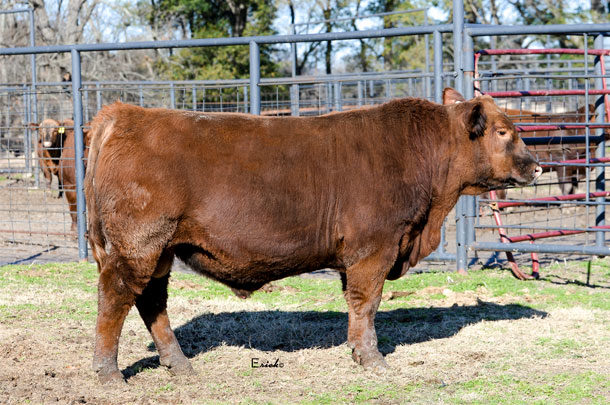Gilchrist bought into Red Alliance 18 years ago and is currently the program’s sale manager and auctioneer.
“It was a small group of Red Angus breeders, primarily based in Texas, that formed a group to bring bulls together as weanlings, develop them and then have an auction annually,” Gilchrist says. The sale location changes from Texas to Oklahoma, and the group has grown since 2002.
“Our group is volatile like any group of breeders you bring together,” Gilchrist says. He went on to say that Red Alliance contains all sizes of cattle producers. This includes bigger producers such as the Chain Ranch, while their smallest producer raises less than 10 head of cattle.
By becoming a member of Red Alliance, participants are able to put up their best Red Angus cattle for auction, and buyers are able to trust that whatever animal they’re buying meets the quality standards of the Red Alliance group.
Bulls are tested and analyzed based on structure, growth data and performance testing, EPDs, ultrasounds and carcass data, scrotal circumference, frame score, disposition, fertility testing and a health examination.
Gilchrist says because all livestock in the sale are Red Angus, it allows participants to see those bulls develop and compare against each other, but with a whole diversified set of genetics and bloodlines.
“Our strength for small breeders is that we do not dictate what bloodlines you can use,” Gilchrist says. “It’s basically your own breeding program. You do not lose your identity – you put your own brand on [the cattle] and your own tattoos. Basically, we’re a marketing group that does not dictate like a co-operatorship where producers would have to use certain genetics.”
Gilchrist not only helps produce the Red Alliance sale each year, but puts his own cattle in the sale as well. “To me, the most exciting part of our venture at Red Alliance is the diversity of bloodlines that give the comparison amongst a wide variety of genetics,” Gilchrist says.
Another appeal of Red Alliance is, because they are compiled of mostly smaller breeders, they know the trials and tribulations other small producers face.
“We’re normal people in the sense that we face the challenges that everyone else does. We’re kind of a group of smaller breeders that are banded together, so we have challenges that some of our bigger competitors don’t face.”
To be a part of Red Alliance, potential members are given approval by a board of current members. The board investigates the potential member, looking at their dedication to the breed and their management expectations.
“A lot of folks that haven’t been in the bull selling business don’t realize that challenges come whether in the ups and downs in the markets,” Gilchrist says. “It is a volatile business, and that hardship is you’re breeding for two and three years down the road for trends that change. You’re dealing with factors on auction day, plus the market of that day, the weather and all the other challenges that come with farming and ranching.”
Members are screened and educated by board members, “so they know what they’re getting into,” Gilchrist says.
Each year, Red Alliance holds a sale mainly compiled of Red Angus bulls, as well as some registered and commercial Red Angus females. The 2019 Red Alliance sale has just recently occurred. Gilchrist says the sale was reflective of the current market, and the group looks forward to their next auction. ![]()
Mayzie Purviance is a freelancer based in College Station, Texas.
PHOTO: A photo of one of the bulls sold March 9 at the Red Alliance Sale in Shawnee, Oklahoma. Photo courtesy of Kyle Gilchrist.







